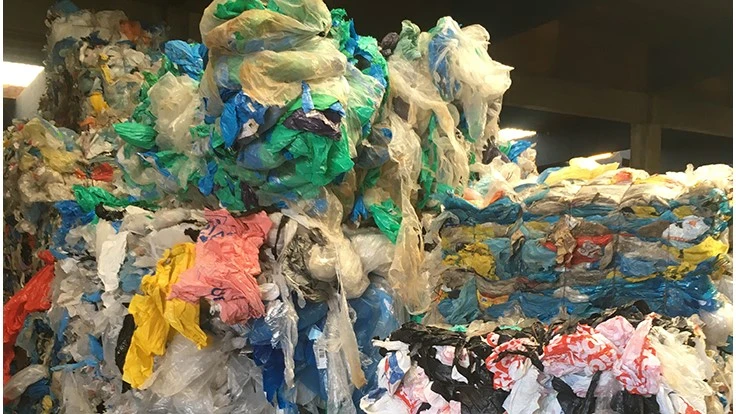
Recycling Today archives
A study commissioned by the Singapore-based Alliance to End Plastic Waste spells out what researchers determined to be nine requirements for feedstock deemed suitable for plastic scrap pyrolysis facilities.
The study, conducted by United Kingdom-based Eunomia Research & Consulting, is titled “Feedstock Quality Guidelines for Pyrolysis of Plastic Waste.” While the backers of some chemical or “advanced” recycling projects have portrayed their technology as able to handle essentially unsorted varieties of discarded plastic, the Eunomia study did not typically find this to be true for pyrolysis systems.
Instead, a characterization of the Eunomia study by the Alliance to End Plastic Waste says pyrolysis systems “generally required well-sorted, clean feedstock comprising about 85 percent polyethylene (PE) and polypropylene (PP).”
Moisture limits of around 7 percent are recommended in the study. “Indicative thresholds for contaminants should also not exceed 15 percent in total, with additional limits on various categories,” writes the alliance in a news release announcing the completion of the study.
The Eunomia research “further underscored the need for robust collection and sorting systems to supply quality feedstock to both chemical and mechanical recyclers as part of a plastic circular economy,” the alliance adds. More than 30 companies and organizations involved in the plastics sector in Asia, North America and Europe were interviewed, according to Eunomia.
“Improving our knowledge of feedstock requirements for pyrolysis can help progress the industry’s understanding of how chemical recycling and mechanical recycling can work alongside each other,” says Martyn Tickner, chief advisor of the Technical Solutions Centre at the alliance.
Tickner continues, “Stakeholder groups ranging from packaging manufacturers to government agencies are interested in the potential of chemical recycling to add a new dimension to plastic [scrap] recycling, with the expectation that the technologies will complement increasingly advanced mechanical recycling. We hope this white paper serves as a starting point for discussions between pyrolysis operators and material suppliers on the types of recycling systems and feedstock that need to be developed.”
Sarah Edwards of Eunomia says, “Specification guidelines largely exist for mechanical recycling, although final specifications are always agreed between the buyer and seller. The pyrolysis specification that resulted from the research is a guideline, and the technology providers and operators we consulted had slightly different requirements.”
She adds, “As the review was focused on pyrolysis, it is important to note that there are other advanced recycling technologies. As policy helps drive up recycling rate targets, understanding the specification of plastics that can be managed through other advanced recycling will be critical for sorters as well as mechanical recyclers.”
Eunomia and the Alliance to End Plastic Waste describe pyrolysis as the breaking down of plastic scrap at high temperatures without oxygen to produce pyrolysis oil, which can be used in the production of new plastics as a replacement for fossil feedstocks. The process can target flexible PE and PP to create market demand for these materials, which can be difficult to reprocess via mechanical recycling methods. “This further complements mechanical recycling processes which focus on rigid plastics,” the alliance says.
Regarding limitations, the two entities say not all packaging—especially multimaterial films—is suited for pyrolysis. “Overcoming this will require more circular design together with a transition to multimaterial or more simple films that fulfill the requirements above,” states the alliance.
Packaging items such as plastic bags, films, sachets and wrappers comprise as much as 45 percent of the discarded materials generated in households, according to the alliance.
The aim of the completed study was to provide “clarity on feedstock requirements and propose model specification guidelines that can be used to enable greater alignment across the recycling value chain,” states the Alliance to End Plastic Waste. Adds the group, “This is especially as feedstock considerations will continue to evolve, and clearer standards on optimal feedstock quality will emerge as the sector matures.”
The full report is available for downloaded from this web page.
Latest from Recycling Today
- Orion ramping up Rocky Mountain Steel rail line
- Proposed bill would provide ‘regulatory clarity’ for chemical recycling
- Alberta Ag-Plastic pilot program continues, expands with renewed funding
- ReMA urges open intra-North American scrap trade
- Axium awarded by regional organization
- Update: China to introduce steel export quotas
- Thyssenkrupp idles capacity in Europe
- Phoenix Technologies closes Ohio rPET facility





